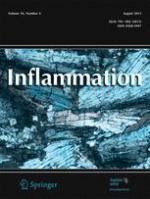Citation:
Ginsburg I, Lahav M, Giesbrech P. Effect of leukocyte hydrolases on bacteria XVI. Activation by leukocyte factors and cationic substances of autolytic enzymes in Staphylococcus aureus. Inflammation. 1982;6 (3) :269-284.

Abstract:
Effect of leukocyte hydrolases on bacteria XVI. Activation by leukocyte factors and cationic substances of autolytic enzymes in Staphylococcus aureus: modulation by anionic polyelectrolytes in relation to survival of bacteria in inflammatory exudates. The mechanisms involved in the activation of autolytic enzymes in Staphylococcus aureus, by leukocyte extracts, cationic proteins, phospholipase A2, amines, and membrane-damaging agents was studied in a resting cell system as well as by growing staphylococci. The bacteria were labeled with [14C]N-acetylglucosamine and were subjected to a variety of agents either in 0.1 M acetate buffer, pH 5.0, or in phosphate buffer, pH 7.4. While intact log-phase cultures were found to undergo partial autolysis at pH 5.0 and almost complete lysis at pH 7.4, both heat-killed bacteria and bacterial cell walls were completely resistant to autolysis in buffers. Autolysis at pH 5.0 can be further activated by leukocyte extracts, nuclear histone, crystalline ribonuclease, egg-white and human lysozyme, phospholipase A2, as well as by spermine, spermidine, and polymyxins B and E. The addition of viable log-phase bacteria to radiolabeled heat-killed staphylococci or to radiolabeled cell walls which had been cleaned off autolytic enzymes resulted in degradation of the radiolabeled targets. The data suggest that the various inducers of autolysin activation caused leakage of autolytic enzymes from the intact bacteria which attacked the depolymerized the bacterial cell walls. Anionic polyelectrolytes like heparin, dextran sulfate, suramine, polyglutamic acid, and liquid (polyanethole sulfonic acid) markedly inhibited both spontaneous and induced lysis. Staphylococci which had grown in the presence of anionic polyelectrolytes became highly resistant to lysis triggered by any of the inducers of autolysis. Since inflammatory exudates are known to be rich in anionic polyelectrolytes, it is suggested that the prolonged survival of intact bacterial cells in such a milieu may be due to the inactivation of autolytic enzymes. It is also postulated that the degradation of certain bacterial species following phagocytosis or extracellular degradation may not be the result of the action of hydrolytic enzymes but rather the result of activation by leukocyte factors of autolytic enzymes which lead to bacteriolysis.Publication Global ID: http://www.ncbi.nlm.nih.gov/pubmed/6182097

